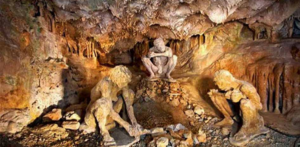The Theopetra Cave is an archaeological site located in Meteora, in the central Greek region of Thessaly. As a result of archaeological excavations that have been conducted over the years, it has been revealed that the Theopetra Cave has been occupied by human beings as early as 130,000 years ago. In addition, evidence for human habitation in the Theopetra Cave can be traced without interruption from the Middle Paleolithic to the end of the Neolithic period. This is significant, as it allows archaeologists to have a better understanding of the prehistoric period in Greece.
Occupation of the Theopetra Cave
The Theopetra Cave is situated on the northeastern slope of a limestone hill, about 100 m (330 ft above a valley. The cave overlooks the small village of Theopetra, and the Lethaios River, a tributary of the Pineios River, flows nearby. According to geologists, the limestone hill was formed between 137 and 65 million years ago, which corresponds to the Upper Cretaceous period . Based on the archaeological evidence, human beings only began to occupy the cave during the Middle Paleolithic period, i.e., around 130 000 years ago. The cave itself has been described as roughly quadrilateral in shape with small niches on its periphery and covers an area of about 500 sq meters (5380 sq ft). The Theopetra Cave has a large entrance, which allows light to enter abundantly into the interior of the cave.
5th-Century A.D. Children’s Cemetery Found in Anatolia near eastern Roman (Byzantine) Church
Investigation Begins
The archaeological excavation of the Theopetra Cave began in 1987 and continued up until 2007. This project was directed by Dr. Nina Kyparissi-Apostolika, who served as the head of the Ephorate of Palaeoanthroplogy and Speleography when the excavations were being carried out. It may be mentioned that when the archaeological work was first conducted, the Theopetra Cave was being used by local shepherds as a temporary shelter in which they would keep their flocks. It may be added that the Theopetra Cave was the first cave in Thessaly to have been archaeologically excavated, and also the only one in Greece to have a continuous sequence of deposits from the Middle Paleolithic to the end of the Neolithic period. This is significant, as it has allowed archaeologists to gain a better understanding of the transition from the Paleolithic to the Neolithic way of life in mainland Greece.
Continue here: Ancient Origins
Ask me anything
Explore related questions





